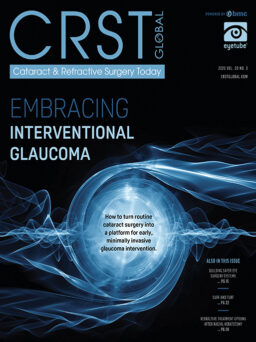1.Why did you decide to become an ophthalmologist?
I decided to become an ophthalmologist when I first attended ophthalmology lectures at the University of Santiago de Compostela, Spain. I was impressed by the refinement of the microsurgical techniques. They seemed exquisite to me, especially microsurgical techniques for cataract and corneal surgery. Each delicate surgical step is built on the success of the previous step to achieve an uncomplicated outcome. I was interested in optics, but I also enjoyed infectious and inflammatory diseases. With ophthalmology, I realized I could have a combination of all my interests. Additionally, my work provides me with a great deal of satisfaction, as it has a considerable impact on patients’ quality of life. Approximately 80% of the information we receive from our five senses comes through the eyes.
2. Have recent trends influenced your surgical technique or the technology that you use?
I specialize in corneal, cataract, and refractive surgery. In my practice, the most important advances that have influenced my surgical technique have been the introductions of lamellar corneal surgery, microincision cataract surgery, premium IOLs, and intrastromal corneal ring segments.
3.What do you enjoy most about conducting research, and what is your current focus?
Research is a combination of challenge, intrigue, and satisfaction. It requires—and provides—the opportunity for teamwork with colleagues from ophthalmology and other disciplines. Working in a group encourages medical and scientific exchange.
Research related to cornea, ocular surface, and cataract and refractive surgery. I performed my thesis at the University of Santiago de Compostela on a cyclosporine delivery system to prevent corneal transplant rejection in rabbits. Later, I trained at Moorfields Eye Hospital, London, with John Dart, MA, DM, FRCS, FRCOphth, studying inflammatory diseases of the cornea and conjunctiva. I also worked on infectious keratitis, which is one of my preferred areas of interest, including infectious complications after corneal refractive surgery. Recently, I had the opportunity to collaborate with Ramón Lorente Moore, MD, PhD, at the Complexo Hospitalario de Ourense, on several issues related to cataract surgery. Currently, our team is focused on lamellar corneal transplant surgery and eye banking.
4. What is your advice to young ophthalmologists, particularly women, who are new to practice?
I have three main messages: work hard, be constant in your endeavors, and set priorities. Once a preferred area of practice has been chosen, I would encourage young ophthalmologists to work at a center of excellence and become involved in research. Establishing contacts and working with talented professionals is an exciting and stimulating way to learn. Circumstances may vary widely, but no matter how adverse they become, I emphasize the importance of being constant and committed. Young people should search for their own opportunities, as opportunities will not search for them, and it is always uncertain what the future holds. As a mother of three children, I have learned to develop time management skills and to focus on the truly important issues. Children teach you how to do this.
5. If you could live anywhere in the world, where would it be?
I live in Santiago de Compostela, and I love living here. The city is a United Nations Educational, Scientific, and Cultural Organization (UNESCO) World Heritage Site. The city’s cathedral is the destination of an important ninth century medieval pilgrimage route, the Way of St. James. It is one of Spain’s most monumental towns, with a beautiful cathedral, medieval buildings, and charming streets. I am not planning to move any time soon.




